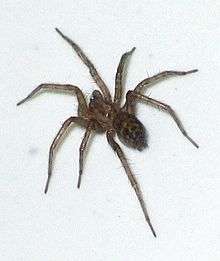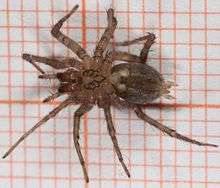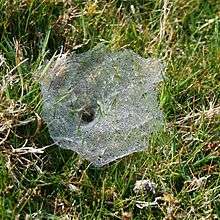Tegenaria domestica
The spider species Tegenaria domestica, commonly known as the barn funnel weaver in North America and the domestic house spider in Europe, is a member of the funnel-web family Agelenidae and a close relative of the hobo spider.
| Tegenaria domestica | |||
|---|---|---|---|
 | |||
| Female | |||
| Scientific classification | |||
| Kingdom: | Animalia | ||
| Phylum: | Arthropoda | ||
| Subphylum: | Chelicerata | ||
| Class: | Arachnida | ||
| Order: | Araneae | ||
| Infraorder: | Araneomorphae | ||
| Family: | Agelenidae | ||
| Genus: | Tegenaria | ||
| Species: | T. domestica | ||
| Binomial name | |||
| Tegenaria domestica | |||
| Synonyms[1] | |||
| |||
Domestic house spiders range worldwide from as far north as Scandinavia to as far south as Greece in Europe. It is recorded in the checklist of Danish spider species.[2]
It is found from as far north as Maritime Canada to as far south as Louisiana in North America. Some also inhabit parts of Western Asia.[3]
Common belief has it that T. domestica, first only occurring in Europe, was accidentally introduced to the Americas by British lumber merchants during the Napoleonic Wars era along with wooden cargo exported over the Atlantic Ocean. Recent arachnological studies, however, suggest that the species had a common ancestor with the giant house spider that spread to both Europe (through Asia) and the rest of North America from Northwestern Canada (possibly from a region currently including British Columbia) long before the first human settlement in North America.
Appearance


Domestic house spiders possess elongated bodies with a somewhat flattened cephalothorax and straight abdomen. Their body/legs ratio is typically 50–60%, which accounts for a body size of 7.5–11.5 mm (0.30–0.45 in) in females and 6–9 mm (0.24–0.35 in) in males.[3]
Males are usually distinguished from females by having longer, more agile legs, bloated pedipalps and elongated abdomen. Other distinctions are strictly behavioral.
The coloring of an adult T. domestica is typically dark orange to brown or beige (maybe even grayish), with a common characteristic of striped legs and two dull, black, longitudinal stripes on the cephalothorax. The abdomen is mottled in brown, beige, and grey and has a pattern of chevrons running lengthwise across the top (similar to an argyle pattern).
Behavior

Barn funnel weavers are active and agile hunters, relying on both their vision and movement speed as well as web mechanisms. Their eye configuration, with six out of eight sighting forward, allows them to distinguish even the smallest movement in front of them and either follow it, or retreat if the movement is too large. These spiders are also known to be photosensitive, i.e. moving to or fleeing from the light, depending on situations.
Like many agelenids, barn funnel weavers are very precise in their movements. Instead of following a continuous gait pattern, they usually move in short intervals, stopping several times before deciding where to head next. Males will wander aimlessly around the house if undisturbed, but will soon switch to the running interval if prey or threat are spotted. Their legs are perfectly fit for walking (with tarsi bent outward on the tips) and spiders can run over quite long distances in both situations.
This spider builds a funnel-shaped web to catch its prey. It usually consists of a multitude of stressed silk threads spun over a flat surface (such as a window sill) near any corner, with a funnel-like structure reaching for the corner, in which the spider would typically reside (hence the name). These webs can become quite large if undisturbed. They act like cord strings, helping the spider glide over them, and once a prey stumbles into the web, it will quickly get attacked, then dragged inside the funnel part and eaten, but very rarely stored underneath the structure.[4]
Females that dwell indoors would usually live for over one or two years on the same web, with some residing for as long as seven years in rarely disturbed places (attics, basement or cellar parts, storage rooms, etc.). Outdoor females perish with cold weather and males rarely live for over a year. In late fall (autumn), an egg sac is made containing up to 50 eggs and put in the very tip of the funnel, protected by the female.
Defense mechanisms
T. domestica is not a particularly aggressive species and will often retreat when confronted. As long as its web is undisturbed, the spider will usually retreat to the funnel tip and stop responding to any movement whatsoever. If the web is attacked and partially destroyed, the spider will attempt to flee the area or may huddle its body into a ball against the wall or some other nearby object. To usher the spider into a container for removal, place open end in front of the spider and use the container lid if so equipped or similar object to push or corral the spider from behind. Since a spider's first reflex after being disturbed from the rear is to move forward, usually the spider will advance into the container placed in front of it.
Tegenaria species rarely bite. If they do, the bite is painless.[5]
References
- "Taxon details Tegenaria domestica (Clerck, 1757)". World Spider Catalog. Natural History Museum Bern. Retrieved 2017-09-25.
- Checklist of Danish Spiders (Araneae). Version 26-10-2011 (list)
- Steve Jacobs (2012). "Barn Funnel Weaver spider". Penn State Department of Entomology. Retrieved 2007-05-14.
- Christopher Hunt. "Species Tegenaria domestica - Barn Funnel Weaver - BugGuide.Net". Iowa State University. Retrieved 2007-05-27.
- "Tegenaria spp. - British Arachnological Society". British Arachnological Society. 2013. Retrieved 2013-07-06.
External links
| Wikimedia Commons has media related to Tegenaria domestica. |